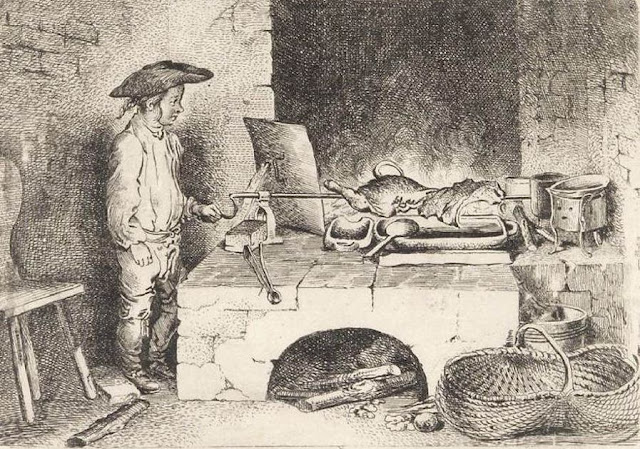THINGS TO KNOW BEFORE PURCHASING A SPIT ROTISSERIE MOTOR
It’s hard to believe that the original spit roast users
took turns in rotating the rotisserie skewer by a crank handle! Thank goodness
someone finally realised there was an easier way hance the discovering of the
modern rotisserie motor.
 |
| Turning a spit roaster by hand for hours on end was a mighty hard job |
 |
| Look for a motor with metal gears |
Now I’ve heard there are still a few people out there
selling rotisserie motors made out of old windscreen wipers and washing machine
parts, however the vast majority of rotisserie motor available online (and most
certainly in stores) are factory produced gear driven motors.
There are various types of rotisserie motors to choose
from, all which serve a different purpose. To help you decipher between the
different choices available I have listed below the top 5 things you should
consider before investing in a rotisserie motor.
Power :
 1.5v – These are rotisserie motors which operate using 1 D
cell battery. They are usually very light weight and can only turn a small
amount of meat, usually a few kebabs or souvlakis. 1.5v rotisserie motors are
relatively inexpensive, however will burn out more quickly.
1.5v – These are rotisserie motors which operate using 1 D
cell battery. They are usually very light weight and can only turn a small
amount of meat, usually a few kebabs or souvlakis. 1.5v rotisserie motors are
relatively inexpensive, however will burn out more quickly.
3v - 2 D cell batteries are used to power a 3v rotisseriemotor. Similar to its 1.5v cousin, these rotisserie motors are only used to
cook a dozen or so kebab skewers, or small rolls of meat up to about 5 kgs. 3vrotisserie motors are quite cheap, usually around the $30-$50 mark, however
they really are only designed for cooking for a small group of people.
 12v – Rotisserie motors which operate off 12v are great for
campers or anyone who will be using a rotisserie where normal mains power isn’t
available. 12v rotisserie motors are usually weaker than 240v rotisserie
motors, so keep that in mind when considering what type of meat you will be cooking.
12v – Rotisserie motors which operate off 12v are great for
campers or anyone who will be using a rotisserie where normal mains power isn’t
available. 12v rotisserie motors are usually weaker than 240v rotisserie
motors, so keep that in mind when considering what type of meat you will be cooking.
240v - The vast majority of spit roast users will be using
their rotisserie motor at home or somewhere where 240v mains power is available.
They vary in differing load capacity from 5kgs to 100+kgs. A 240v rotisserie motor is generally recommended for most rotisserie users.
Capacity:
 Before going out and purchasing a rotisserie motor, you
need to consider how many kilo’s of meat you would be likely to turn. There is
no point buying a 20kg rotisserie motor if you are planning on cooking decent
size pigs, conversely, if you are only intending on cooking a couple of kilo’s
of meat using the rotisserie on your 4 burner BBQ, don’t waste your money on an 80kg capacity motor.
Before going out and purchasing a rotisserie motor, you
need to consider how many kilo’s of meat you would be likely to turn. There is
no point buying a 20kg rotisserie motor if you are planning on cooking decent
size pigs, conversely, if you are only intending on cooking a couple of kilo’s
of meat using the rotisserie on your 4 burner BBQ, don’t waste your money on an 80kg capacity motor.
If you are going to cook a whole animal, the minimum
capacity you should be purchasing is 20kgs.
Speed:
5 revolutions per minute seems to be optimum.
I have used rotisserie motors which turn 15RPM and those
which turn 2 RPM. The 15RPM rotisserie motors spin way too fast and the 2RPM
rotisserie motors tend to burn out.
People often ask me whether I recommend a rotisserie motor
which has a variable speed. Personally I wouldn’t bother with a variable speed
rotisserie motor, when you’ll just have it running at 5RPM anyway. The risk
with the variable speed rotisserie motors is when you slow the RPM down to 1 or
2 RPM and you have a decent sized piece of meat on there, too much stress is
placed on the rotisserie motor and it will burn out. Each to their own though!
Output shaft
1.5v or 3v rotisserie motors tend to be suited for 4-6
burner BBQ’s or small 8mm square skewers. You can’t cook a large piece of meat
on a small square skewer because it will bow in the middle, therefore if you
want to cook a piece of meat more than about 5 kilo’s, you can’t use a 1.5v or
3v rotisserie motor.
The output shafts for 12v and 240v rotisserie motors will
vary. Most will be round, however the occasional one will be square. I know I’m
stating the obvious, however if you have a 22mm round skewer, don’t purchase a
rotisserie motor with a 19mm output shaft. It’s ok if the output shaft is
slightly larger than your rotisserie skewer, however anything more than a
couple of millimetres, and I would recommend getting a sleeve made to reduce
the amount of movement between your skewer and rotisserie motor.


No comments:
Post a Comment